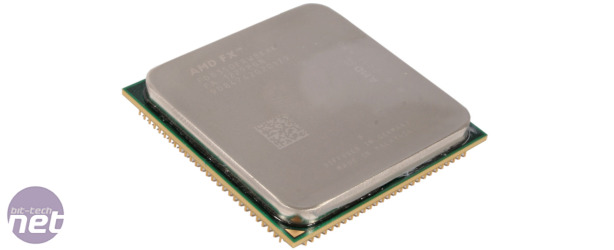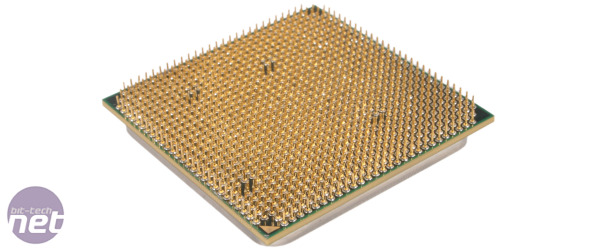
Performance Analysis
Back when we first looked at its Bulldozer core, AMD told us that ‘the AMD FX processor, with its radical new design, represents a new way of processing that can be limited in previously compiled applications and OSes. It is important to optimise data loads into the processor and this requires an update to the compilers generating code for the processor and an update to the Operating System Scheduler.’ Well clearly those updates haven’t materialised (we did test with the suggested hot-fixes for Windows 7 applied), because, while an undoubted improvement over the FX-8150 and its Bulldozer architecture, the FX-8350 is still uncompetitive across a whole range of benchmarks.There are some wins for AMD though, although unsurprisingly they’re in heavily multi-threaded environments. In Cinebench the FX-8350 produced a score of 6.92 at stock; a fifteen per cent increase over the performance of the FX-8150 and 0.6 points ahead of the Core i5-3570K, although still behind the stock score of both the i7-2600K and i7-3770K. Overclocked to 4.8GHz the FX-8350’s score rose to 8.25 points , again out-pacing the i5-3570K, even when overclocked to 5GHz.
In Wprime’s 32M test the FX-8350 again demonstrated a healthy improvement over its predecessor with a time of 8.754 seconds at stock and 7.354 seconds when overclock. This also saw the FX-8350 better the i5-3570K at stock and when overclocked, again an indication of the Piledriver architecture’s superior multi-threaded performance.
Beyond such multi-threading optimised benchmarks though, the FX-8350’s performance drops off very quickly indeed. Our Media Benchmarks simulate heavy image editing, video encoding and multi-tasking workloads and the FX-8350 proved slower than the i5-3570K in all three tests, sometimes by a huge amount. In the image editing portion the FX-8350 scored just 1020 points; while this is an improvement over the FX-8150’s score of 887, it’s still slower than AMD’s Phenom II X6 1100T in the same test, a CPU based on the K10 architecture. In comparison the i5-3570K score 1862 in this test, an 82 per cent advantage in performance.
The multi-core nature of the architecture makes the FX-8350 more competitive in our handbrake H.264 video encoding test, but a score of 2,701 points at stock and 3,164 points when overclocked is still slower than Intel’s Core i5-2500K, let alone the Ivy Bridge i5-3570K which scores 3,1160 points at stock and 4,245 when overclocked.
In our final multi-tasking test we were surprised to find that the FX-8350 no faster than its predecessor, with the minor difference in the two chips scores down to per-run variance rather than any drop or rise in performance. This is obviously a little baffling, as the FX-8350’s higher frequencies and optimisations mean we should have seen an improvement here. Clearly then performance here is stymied elsewhere, either in the 990FX platform or the FX-8350’s cache structure, which remains unchanged from Bulldozer.
The overall result is pretty bad reading for AMD, with an overall tally of 1,660 points at stock and 1,914 points when overclocked. While this is at least faster than Intel’s Nehalem based i7-920 at stock, it’s a long way behind Intel’s Core i5-3570K , which score 2,248 points at stock and 2,851 points when overclocked. The only plus point we can really take is that the gap between AMD and Intel hasn’t grown; overall the FX-8150 was 26 per cent slower at stock than the i5-2500K, and the FX-8350 maintains this gap to the i5-3570K, despite it’s £50 comparative price cut.

While an improvement over the FX-8150, single-threaded performance such as that in the majority of PC games, was a real disappointment
In our Skyrim CPU benchmark, the FX-8350’s poor single-threaded CPU performance really shows through, as it gets comprehensively demolished by the competing Intel chips. A minimum frame rate of 50fps at stock and 61fps when overclocked, while improvements over the FX-8150, are both well below the 94fps stock minimum frame rate possible with an Intel Core i5-3570K, with overclocking driving that minimum frame rate up to 111fps.
In Shogun 2’s CPU test the gap isn’t as jarring, and the FX-8350’s minimum frame rate of 17fps at stock is close to its predecessor’s minimum frame rate of 18fps when overclocked to 4.8GHz. However, again the Core i5-3570K comes out the easy victor, with a minimum frame rate of 28fps at stock and up to 36fps when overclocked. Clearly for those interested in high-performance gaming, the FX-8350 is a sub-standard CPU.
There is good news when it comes to power consumption though. A system idle power consumption of 95W at idle is a 10W drop from the FX-8150, while a load system power consumption of 213W is a 30W improvement. Lower power consumption and a clock bump without a die-shrink? Perhaps AMD has made a particularly tasty sacrifice to the CPU gods, because these are characteristics we’d usually expect from a lower nm production process. A higher core voltage when overclocked results in a higher idle power consumption of 160W when running at 4.8GHz. However, with no need to increase chipset voltages, load power consumption is a whopping 222W lower than the FX-8150 at the same frequencies.

The FX-8350 is an improvement over Bulldozer, but doesnt disrupt Intel's dominance of the enthusiast CPU segment
Conclusion
AMD has done a lot to improve the FX-8350 considering the lack of usual CPU architecture improvements. With no change in die size, TDP or production process, its managed to squeeze up to 15 per cent more performance out of this chip, all whilst lowering power consumption making overclocking incredibly simple and shipping the chip at much more competitive £150 price point. In these regards, we are thoroughly impressed, and it's fair to say this is a much better offering than the FX-8150 of 12 months ago.However, the overall result, while not as disheartening as the FX-8150, is still a distant second to Intel’s Core i5-3570K and associated Ivy Bridge architecture. It doesn't so much change the status quo as reinforce it.
AMD remains deeply uncompetitive in primarily single threaded applications such as games without offering the significant benefits in multi-threaded applications you’d expect from a chip boasting eight cores. Peak power consumption remains higher than Intel too and it’s these fundamental issues that mean the FX-8350 just isn’t a competitive CPU. Despite the drop in price, there’s almost no reason to opt for the FX-8350 in comparison to the Intel competition; it seems that while AMD’s changed lots of little things about the FX-8350, the end result remains largely the same.
-
Value19 / 35
-
Features11 / 15
-
Performance37 / 50


MSI MPG Velox 100R Chassis Review
October 14 2021 | 15:04









Want to comment? Please log in.